19th CENTURY SILVER WINE TASTER
Marks Attributed to Karl Kurz, Hanau, Germany
British Silver Import Marks for Samuel Boyce, Landeck, London 1902-3
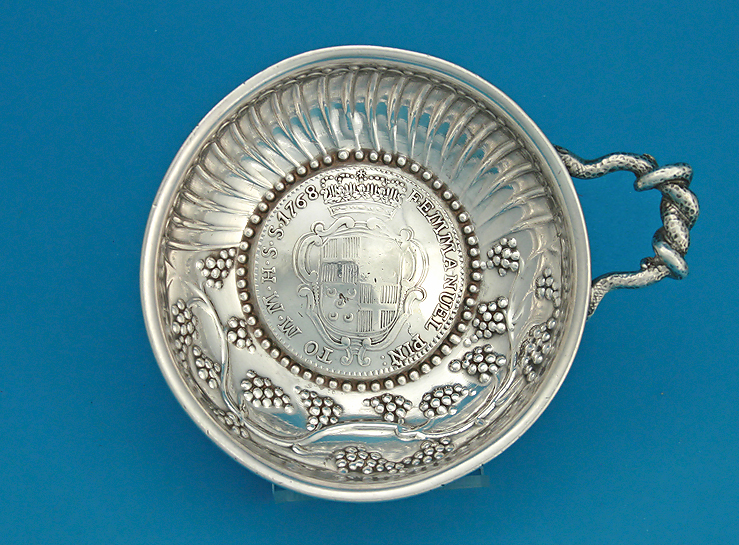
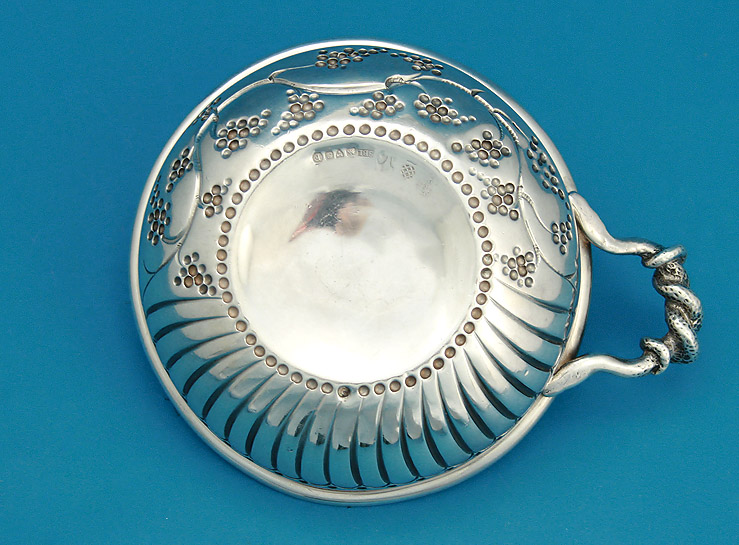
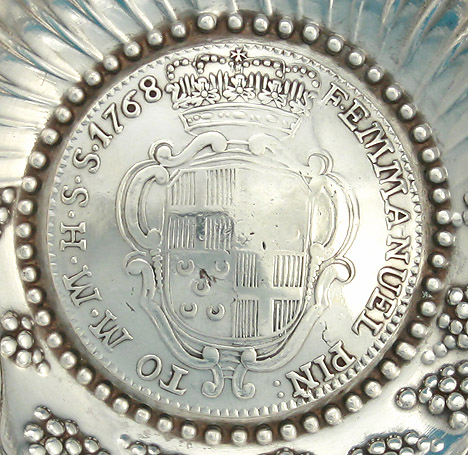
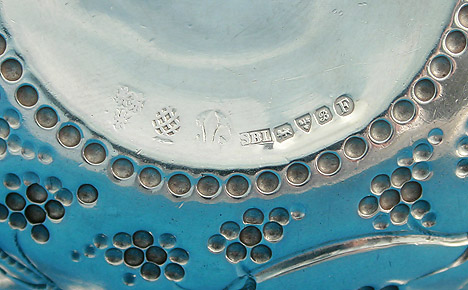
Of heavy gauge sterling, the deep circular form, centering a silver Knights of St. John coin (Malta) inscribed
“Emmanuel Pinto M. M. H. S. S. 1768” around a coat of arms with crosses and five red crescents beneath a crown*,
the coin surrounded by beading, one bowl side with beads and flutes, the other with a fruiting grape vine,
within a rounded lip, intertwined serpent handle
Marks: pseudo-antique marks used by Karl Kurtz; English import marks
(lion passant), (Chester), SBL, B, F
Condition : Excellent
1-1/8” High x 3-1/4” Diameter (the bowl); 4” Wide over handle
3.28 oz.
SOLD
#6121
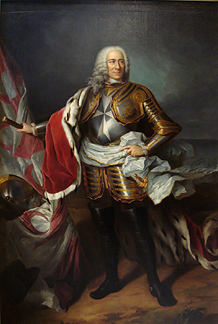
Dom Frei Manuel Pinto da Fonseca (1681 – 23 January 1773) was a Knight of the Langue of Portugal. He was the 68th
Grand Master of the Order of the Holy Religion of the Knights of St John of Jerusalem, of Palestine, of Rhodes, and called Malta,
from 1741 to 1773. He was a Portuguese Nobleman, the son of Miguel ?lvaro Pinto da Fonseca, Alcaide-M?r de Ranhados,
and wife Ana Pinto Teixeira.
He was elected on 18 January 1741. On 25 May 1743 he gave his name to the then town of Qormi giving it the status of a city
(Citt? Pinto). In 1749, one of his bodyguards, Cassar, refused to join a plot led by Pasha Mustafa to stage a Muslim slave revolt.
This refusal led to the exposure and suppression of the revolt. This event was then celebrated on every anniversary, 29 June.
Pinto created several new noble titles, which was greatly resented by some of the older nobles of Malta and gained a reputation
for imposing heavy taxes. He expelled the Jesuits from Malta. He completed the Auberge de Castille, one of the most important
buildings in the capital city, Valletta, which had been started in 1574 and his bust and arms adorn its fa?ade. Today this building
houses the Office of the Prime Minister. He made substantial donations to the Conventual Church, and of the most notable
mementos worth mentioning are two large and heavy bells cast by the Master Founder of the Order of St. John, Aloisio Bouchut
in 1747 and 48 respectively which still hang in the belfries of the Co-Cathedral. Pinto built several storehouses on the Marina,
which still bear his name. When he died his body was laid to rest in a monument with a mosaic portrayal of him.
This is a major tourist attraction in Malta.
He was a friend of legendary Cagliostro.
*His coat of arms portrays five red crescents symbolizing that he once defeated five Ottoman Turks single-handedly. The city of Qormi
adopted this as its own coat of arms and flag. Actually, those are the Arms of the Pinto family with the enamels exchanged.
The Pinto family is probably the oldest family in Portugal.
He had an illegitimate son by one Rosenda Paulichi, daughter of Alberigo Paulichi and wife Patronilla Ramuzetta, named Jos? Ant?nio
Pinto da Fonseca e Vilhena, who married his first cousin Maria In?cia Pinto da Fonseca de Sousa Teixeira e Vilhena, illegitimate
daughter of Francisco Vaz Pinto (his father's brother) by one Clara Cerqueira.
ABOUT HANAU HALLMARKS
From c1850-1900, copies of old silver, and items designed in an amalgamation of historic styles, were in fashion.
Many firms in Europe and in the United States produced this type of silver. Usually the recognition of reproduction
silver is not problematic, as it is marked according to the laws of the country of origin. However, the antique silver
makers of Hanau chose to mark its wares with “fantasy marks” – much as many 19th century Chinese ceramics are
marked. It is unclear is the intent was decorative or to deceive. The spurious marks somewhat resemble old marks,
and are appropriate to the style of the piece – i.e. French rococo style reproductions marked with French looking marks,
German seventeenth century-inspired pieces with German-looking marks, etc., most styles also being reminiscent of 17th
and 18th century maker's marks. This type of mark stamping practiced in Hanau would have been illegal in France,
England, or German cities where a guild supervised the marking – as the various assay offices in the UK. Hanau,
however, had a long tradition as a “free-trade city”.
With the production of "antique silver", Hanau found a market niche, which brought its silver manufacturers enormous
prosperity and worldwide reputation. The 'father' of this industry was August Schleissner. The other leading firm of Hanau
was Neresheimer, founded in 1890 as a partnership of August and Ludwig Neresheimer with Jean Schlingloff. Right from
the start Neresheimer offered a wide range of highly decorative objects like nefs, tankards, coconut and nautilus cups, and
other sumptuous sideboard pieces.
Hanau pieces in the antique style were usually made with silver ranging from about 750/1000 to 835/1000.
Sterling (925/1000) was rarely used – usually on pieces made for export to Britain and the United States.
We welcome and encourage all inquiries. We will make every attempt to answer any questions you might have.
For information, call (901) 761-1163 or (901) 827-4668 or email mfcreech@bellsouth.net
American Express, Mastercard, Visa and Discover accepted
|
Accessories Ceramics Early Asian Ceramics Fine Art Furniture Glassware Silver Home |